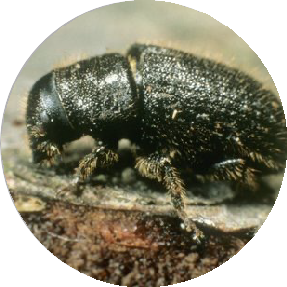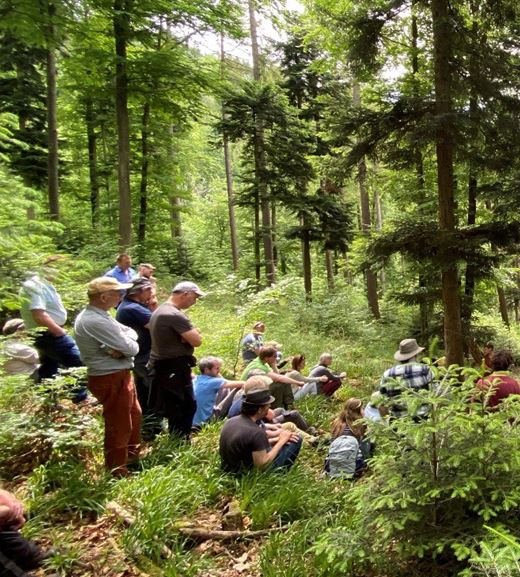FWN38 Autumn 2022 – Resilience & Tree Health
14 December 2022There are several threats to our woodlands and the forest industry it supports, that we as landowners & managers need to be aware of. The first is from pest & diseases, the fungi and insects that can harm our forest resources.
The second major threat comes from climate change, the shifting environmental conditions that can put our forests under stress. The two issues are closely related, many of the predicted changes in climate can also create more favourable conditions for pests & diseases. Some of the current pest & disease threats are summarised below:
Great spruce bark beetle: The great spruce bark beetle (Dendroctonus micans) was first found in the UK in the 1980’s and has been moving northwards over time. It is present in southern Scotland and is advancing into the central belt area. It primarily affects spruce (but can also affect pine). Symptoms include dead & dying crowns and resinous bleeds and entry holes on the main trunk. The good news is that if the beetle is detected, a highly specific predatory beetle can be released to control the infestation.
Although the beetle has been present for in the UK for several decades, a warming climate could potentially increase the activity of the beetle as they begin to take flight more often (and spread further) as temperatures rise above 22.5 degrees. If this increase in activity is met with a parallel rise in the number of stressed host trees in the wider environment (i.e.: through drought) then the problems caused by this beetle could grow.
European spruce bark beetle: The European spruce bark beetle (Ips Typographus) was first found in the UK in 2018 and was promptly eradicated, however in the summer of 2021 several outbreaks were picked up in Kent and Sussex. The beetle has been causing a huge amount of damage in Continental Europe where it has been predating on Norway Spruce, populations of the beetle build up in stressed trees and then attack healthy trees on mass. The level of damage has huge economic and landscape affects, and in many countries has become a pressing political issue. The beetle is of great concern in the UK as our timber industry relies heavily on Spruce.
The European spruce Bark Beetle also prefers stressed or weakened trees, which underlines the fact that we need to pay great attention to the overall health of our woodlands.
Phytophtora ramorum: This is a fungal disease that primarily affects Larch, it is more severe in the west of Scotland due to the wetter climate. Symptoms include crown and
branch dieback, sap bleeds, and ginger looking needles during the spring & summer months when needles would usually appear green and healthy. If ramorum is found a ‘statutory plant health notice’ is issued which requires the affected area to be felled so that disease spread can be slowed or halted. Although an infection is not ideal, timber can still be sold and processed if the correct licenses are in place. Ramorum has caused heavy losses in the more Westerly regions of the UK, and in many areas has heavily impacted the surrounding landscapes.
Phytophtora pluvialis: This disease was first found in Cornwall in September of last year and has since been found on several sites in Wales, Scotland & England. In the UK it is affecting Western Hemlock and Douglas Fir.
Symptoms include dieback and resinous cankers on the stem and on side branches. Research into the spread and severity of P.pluvualis is being carried out to determine impacts and responses, and measures have put in place around current areas of infection to help limit the spread and impact of the disease.
In terms of climate change there are few broad trends that we will have to deal with in Scotland. The first is that summers will become warmer, in the drier eastern areas of Scotland this will put some sites under more drought stress. Winters will also become milder with a decrease in the number of frost days, at the same time winter rainfall is predicted to increase. Additionally our future forests will need to be able to cope with a higher frequency of intense weather events such as drought, high intensity rainfall events, and storms.
Integrating resilience:
The word ‘resilience’ has become a common term in the forestry world, but what does it mean and why is it important? In simple terms a resilient forest is one that absorb and adapts to disturbance (i.e., Climate change, Pests & Diseases). Once we understand what resilience means, the ‘why is it important’ question answers itself; we want productive and biodiverse forests that can withstand change!
There is no one single solution as to how this is achieved, but it all starts with good management that takes account of the local site conditions as well as the broader changes that are on the horizon. Some of the main adaption strategies in the manger’s toolbox include choosing site appropriate species & provenance, and diversifying species choice.
Another strategy is to use a wider of array of silvicultural systems, clear-felling in exposed upland sites but moving towards thinning and continuous cover systems in lowland areas. The solutions will vary by landowner, objective and area; but active and considered management in the key component in building resilience. The risk of not giving due consideration to climate change and pest & disease risk is high; landowners and managers should be integrating resilience into future planning.
Tree diseases can be reported here:
https://treealert.forestresearch.gov.uk/
Sergei Kositzki, Forestry Consultant
Sign up to the FAS newsletter
Receive updates on news, events and publications from Scotland’s Farm Advisory Service


